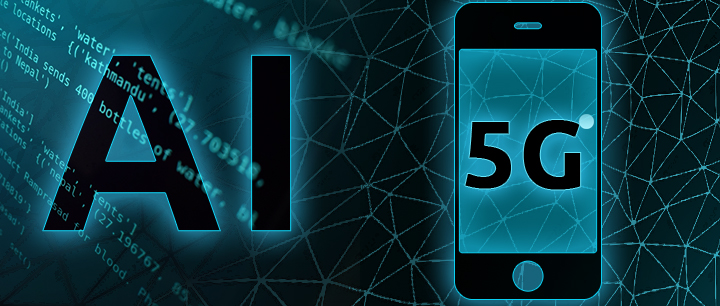The convergence of artificial intelligence (AI) and the cutting-edge 5G technology is poised to inaugurate a fresh epoch of connectivity and communication. These two revolutionary innovations, when intertwined, possess the potential to metamorphose network architectures in unprecedented ways. In this discourse, we shall delve into the manner in which AI and 5G are reconstructing the terrain of network infrastructure, facilitating swifter, more effective, and more astute communication systems.
Table of Contents
The Bedrock: 5G Technology
Before immersing ourselves in the role of AI, it is imperative to comprehend the foundational capabilities of 5G technology. 5G, denoting the fifth iteration of wireless communication, represents a momentous leap from its precursor, 4G. The pivotal facets of 5G that set it apart encompass:
Escalated Velocity: 5G networks proffer notably accelerated data transmission velocities compared to 4G, with the potential of reaching peak speeds of up to 20 gigabits per second. This augmentation in speed is a game-altering development for applications like video streaming, online gaming, and augmented reality.
Minimal Latency: 5G networks exhibit remarkably diminished latency, curtailing the duration required for data to traverse between devices and the network. This minimal latency is of paramount significance for applications such as autonomous vehicles and remote surgery, wherein real-time data transmission is of the essence.
Augmented Capacity: 5G networks possess the capacity to sustain a more extensive array of devices concurrently, rendering them ideal for the burgeoning Internet of Things (IoT) ecosystem. This implies that devices can communicate more proficiently and effectively.
Network Slicing: Through 5G, network operators can establish virtual networks or “slices” customized for particular applications or services. This adaptability guarantees that diverse use cases secure the requisite network resources, culminating in optimized performance.
These attributes, in isolation, render 5G a revolutionary technology. Yet, when harmonized with AI, the prospects for innovation expand exponentially.
The Symbiosis of AI and 5G
Artificial intelligence, steered by machine learning algorithms, is renowned for its prowess in processing copious volumes of data and executing judicious decisions grounded in said data. When amalgamated with 5G, AI can unlock numerous transformative advantages for network architectures and beyond:
Network Enhancement: AI can play an indispensable role in enhancing 5G networks. Machine learning algorithms can incessantly scrutinize network performance data, detect anomalies, and institute real-time adjustments to elevate network dependability and efficiency. This adaptable optimization guarantees the full exploitation of network resources, ultimately heightening the end-user experience.
Prophetic Maintenance: With AI’s assistance, 5G networks can implement prophetic maintenance schemes. By monitoring the performance of network apparatus and scrutinizing historical data, AI can anticipate maintenance requirements, curbing downtime and minimizing service disruptions. This anticipatory approach augments network reliability and service excellence.
Edge Computing: The amalgamation of AI and 5G streamlines edge computing, where data processing unfolds in proximity to the data source, as opposed to centralized data hubs. This empowers real-time decision-making and diminishes latency, rendering it apt for applications such as autonomous vehicles and smart urban centers.
Elevated Security: 5G networks, owing to their heightened connectivity, become more susceptible to cyber intrusions. AI-fueled security solutions can incessantly monitor network traffic, identify irregular patterns, and respond to threats instantaneously. This adaptive security methodology is indispensable for protecting sensitive data and vital infrastructure.
Virtual and Augmented Realities: The elevated speeds and minimal latency of 5G, synergized with AI, foster immersive experiences in virtual and augmented realities. These technologies can be harnessed for a spectrum of applications, spanning from gaming to instructional scenarios and remote collaboration, where seamless and authentic interactions reign supreme.
IoT and Intelligent Devices: The symbiosis of AI and 5G bestows remarkable benefits upon the IoT landscape. AI can scrutinize the colossal quantities of data generated by IoT devices, extracting invaluable insights and enabling intelligent automation. This, in turn, buttresses intelligent households, urban centers, and industrial sectors.
Self-Regulating Systems: Autonomous systems, encompassing self-driving automobiles and unmanned aerial vehicles, heavily lean on AI and 5G. The instantaneous data processing and minimal latency facilitated by 5G networks, coupled with AI’s decision-making capabilities, amplify the safety and efficacy of autonomous navigation.
Healthcare and Remote Medicine: The healthcare domain is progressively adopting AI and 5G for telemedicine and remote patient monitoring. These technologies enable medical practitioners to diagnose and treat patients from afar, heightening access to healthcare services and alleviating the burden on conventional healthcare infrastructure.
Challenges and Deliberations
While the amalgamation of AI and 5G confers substantial advantages, it also begets certain challenges and contemplations:
Data Confidentiality and Security: With the upsurge in data transmission and processing, safeguarding data confidentiality and security assumes paramount importance. Statutes and cybersecurity measures must evolve to shield sensitive information and preserve user confidence.
Infrastructure Investment: The rollout of 5G networks and AI-propelled systems necessitates substantial infrastructure investments. Governments, telecommunications corporations, and technology providers must collaborate to construct the requisite infrastructure to sustain these technologies.
Moral and Regulatory Anxieties: AI’s decision-making aptitude triggers ethical quandaries, especially within autonomous systems. Frameworks and directives must be devised to ensure that AI applications prioritize safety and ethical considerations.
Accessibility and Inclusivity: As AI and 5G technologies progress, it is imperative to ascertain their accessibility and inclusiveness to all communities. Bridging the digital chasm and advocating equitable access to these innovations represents a societal obligation.
In Conclusion
AI and 5G find themselves at the vanguard of a technological renaissance that pledges to redefine how we communicate, labor, and exist. Their harmonious integration possesses the potential to transmute network architectures, optimizing performance, fortifying security, and facilitating a broad spectrum of applications that were once deemed futuristic. As we embrace this novel epoch of connectivity, it becomes imperative to confront the challenges and deliberations to guarantee that these technologies redound to the benefit of society at large. With a judicious approach, AI and 5G can serve as the catalysts for a more ingenious, expeditious, and interlinked world.

